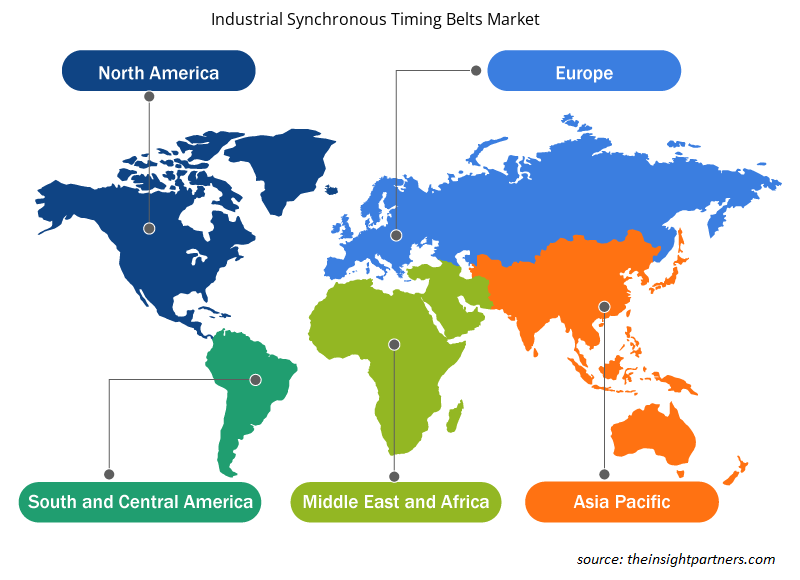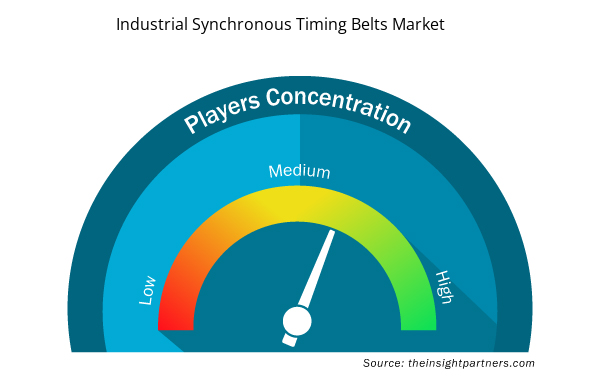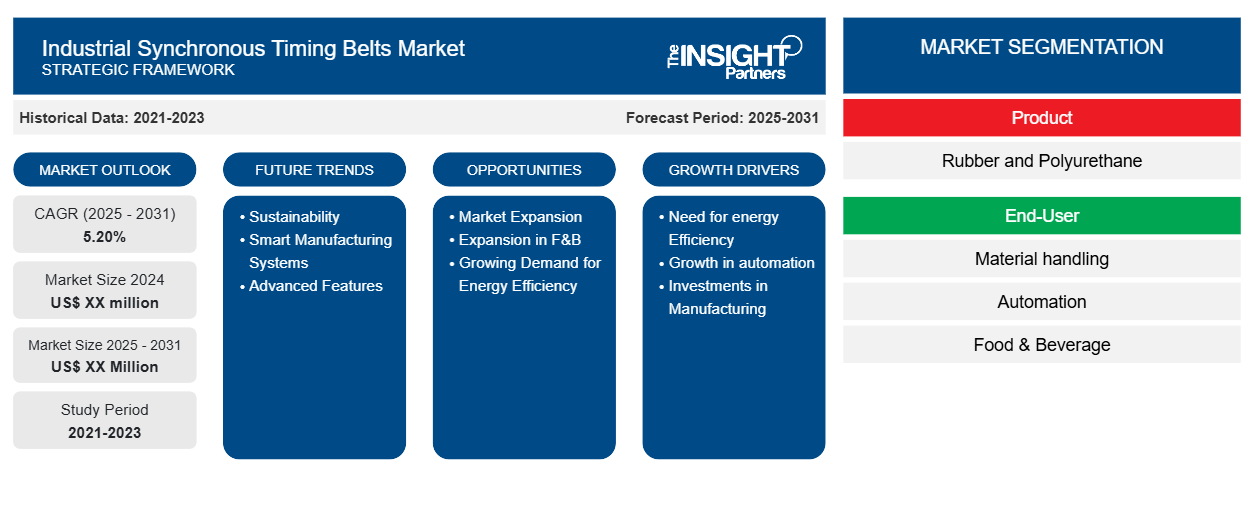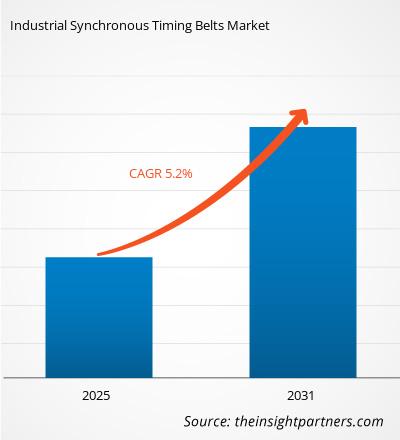The Industrial Synchronous Timing Belts Market is expected to register a CAGR of 5.20% from 2023 to 2031, with a market size expanding from US$ XX Million in 2023 to US$ XX Million by 2031.
The Industrial Synchronous Timing Belts Market report covers analysis by Product (Rubber and Polyurethane) and End-User (Material handling, Automation, Food & Beverage). Geographically, the market is divided into North America, Europe, Asia Pacific, and South and Central America.
Purpose of the Report
The report Industrial Synchronous Timing Belts Market by The Insight Partners aims to describe the present landscape and future growth, top driving factors, challenges, and opportunities. This will provide insights to various business stakeholders, such as:
- Technology Providers/Manufacturers: To understand the evolving market dynamics and know the potential growth opportunities, enabling them to make informed strategic decisions.
- Investors: To conduct a comprehensive trend analysis regarding the market growth rate, market financial projections, and opportunities that exist across the value chain.
- Regulatory bodies: To regulate policies and police activities in the market with the aim of minimizing abuse, preserving investor trust and confidence, and upholding the integrity and stability of the market.
Industrial Synchronous Timing Belts Market Segmentation
Product
- Rubber and Polyurethane
End-User
- Material handling
- Automation
- Food & Beverage
Customize This Report To Suit Your Requirement
You will get customization on any report - free of charge - including parts of this report, or country-level analysis, Excel Data pack, as well as avail great offers and discounts for start-ups & universities
- Get Top Key Market Trends of this report.This FREE sample will include data analysis, ranging from market trends to estimates and forecasts.
Industrial Synchronous Timing Belts Market Growth Drivers
- Need for energy Efficiency: Industrial synchronous timing belts are used in more and more industries because it is a great method to increase energy efficiency in the manufacturing process to save energy. The reason for the growing market is because of cost and energy costs in a lot of industries. And also market share growing up in these putrid. The people and units are paying great attention to the item since the market share growing. The automotive and aerospace industry is paying more attention to efficiency.
- Growth in automation: Automation represents a key factor behind the growth of the industrial synchronous timing belt market. Industries are increasingly adopting advanced technologies, and moving towards the automation of processes. Because of this, demand for industrial synchronous timing belt manufacturers from different sectors is set to swell. The industrial sector, for instance, has been contributing to this market growth as manufacturers increasingly adopt timing belts for synchronous motion and torque transmission applications. In the market analysis, the food processing and packaging industries have been highlighted as major contributors to the increase in demand for industrial synchronous timing belts. Overall, automation trends are creating new developments in different parts of the world, influencing both market size and market dynamics.
- Investments in Manufacturing: Investments in manufacturing and infrastructural developments are fueling the expansion of the global market for industrial synchronous timing belts. According to market reports, with the modernization of facilities and extension of capacities, industries’ demand for superior mechanical systems, including synchronous timing belts, is escalating. This is more evident in the emerging economies witnessing rapid expansions of the manufacturing sectors. Such investments will fuel market growth, changing the dynamics in the market and raising the stakes in the leading regional markets.
Industrial Synchronous Timing Belts Market Future Trends
- Sustainability: Sustainability will be more important in the marketplace: companies are looking at low carbon footprints, and 25% of manufacturers in belt production are using ‘greener’ materials. One of the factors revealed by a pest analysis is that environmental regulations are too strict in some countries. They're forcing companies to innovate. The top players will introduce market strategies based on their green credentials. This will give them an edge in a very competitive sector.
- Smart Manufacturing Systems: More and more industrial synchronous timing belts are being put into smart manufacturing systems by monitoring them in conjunction with the Internet of Things (IoT) to enhance efficiency and eliminate downtime. It is estimated that 30 percent of manufacturers are now using IoT-enabled real-time belt monitoring systems to improve efficiency and reduce downtime. It is also predicted that this trend will speed up as the level of automation increases in the industry. The above text has been rephrased while retaining citations and quotes.
- Advanced Features: Industrial synchronous timing belts are also said to be made of soft plastic material (polyurethane and carbon fiber) to be more wear-resistant and lower maintenance costs. 40% of the new belts are said to use these types of materials to meet up with governmental regulations and eco-conservation efforts. In the PEST analysis on the research, they are saying that industries and key players are investing a lot in Research and Development to follow the growing market and to compete against each other while adjusting to the latest trend in industrial application.
Industrial Synchronous Timing Belts Market Opportunities
- Market Expansion: In mature industrial economies such as Europe and North America, as well as in some heavily industrialized East Asian countries such as South Korea and Taiwan, there is a large-scale potential for growth, through the modernization of aging machinery. In these regions, around 30 percent of installed industrial equipment needs to be modernized. Because belt manufacturers can differentiate their products – for instance, by offering more durable and performing belts – they also have a shot at leading the replacement market. Industry-wise, the Asia-Pacific region is believed to develop fast as the synchronous timing belt manufacturing industry has a great geographical expansion opportunity with its rapid industrialization. For example, countries such as China and India are expected to enhance their industrial output by more than 7% year by year, belt manufacturers can aim at the country to provide high-quality efficiency equipment atl, according to fierce rival analysis.
- Expansion in F&B: As the food processing industry rises globally, such high requirements for synchronous functioning from timing belts will substantially increase. According to the report, more than 70% of food companies would like to use equipment, which can guarantee food safety and efficiency. That provides opportunities for the next development for belt manufacturers. North America which has the possession of food originates superior belt custom requirements because the demand for food processing has to be continuous and accurate working.
- Growing Demand for Energy Efficiency: Industries are seeking solutions that reduce energy consumption and operational costs. Synchronous timing belts, known for their precise power transmission and high efficiency, are becoming a preferred choice over traditional belt systems.
Industrial Synchronous Timing Belts Market Regional Insights
The regional trends and factors influencing the Industrial Synchronous Timing Belts Market throughout the forecast period have been thoroughly explained by the analysts at Insight Partners. This section also discusses Industrial Synchronous Timing Belts Market segments and geography across North America, Europe, Asia Pacific, Middle East and Africa, and South and Central America.

- Get the Regional Specific Data for Industrial Synchronous Timing Belts Market
Industrial Synchronous Timing Belts Market Report Scope
| Report Attribute | Details |
|---|---|
| Market size in 2023 | US$ XX Million |
| Market Size by 2031 | US$ XX Million |
| Global CAGR (2023 - 2031) | 5.20% |
| Historical Data | 2021-2022 |
| Forecast period | 2024-2031 |
| Segments Covered |
By Product
|
| Regions and Countries Covered | North America
|
| Market leaders and key company profiles |
Industrial Synchronous Timing Belts Market Players Density: Understanding Its Impact on Business Dynamics
The Industrial Synchronous Timing Belts Market market is growing rapidly, driven by increasing end-user demand due to factors such as evolving consumer preferences, technological advancements, and greater awareness of the product's benefits. As demand rises, businesses are expanding their offerings, innovating to meet consumer needs, and capitalizing on emerging trends, which further fuels market growth.
Market players density refers to the distribution of firms or companies operating within a particular market or industry. It indicates how many competitors (market players) are present in a given market space relative to its size or total market value.
Major Companies operating in the Industrial Synchronous Timing Belts Market are:
- ContiTech AG
- Gates Corporation.
- Optibelt GmbH
- Svenska Kullagerfabriken AB
- B&B Manufacturing Company, Inc.
Disclaimer: The companies listed above are not ranked in any particular order.

- Get the Industrial Synchronous Timing Belts Market top key players overview
Key Selling Points
- Comprehensive Coverage: The report comprehensively covers the analysis of products, services, types, and end users of the Industrial Synchronous Timing Belts Market, providing a holistic landscape.
- Expert Analysis: The report is compiled based on the in-depth understanding of industry experts and analysts.
- Up-to-date Information: The report assures business relevance due to its coverage of recent information and data trends.
- Customization Options: This report can be customized to cater to specific client requirements and suit the business strategies aptly.
The research report on the Industrial Synchronous Timing Belts Market can, therefore, help spearhead the trail of decoding and understanding the industry scenario and growth prospects. Although there can be a few valid concerns, the overall benefits of this report tend to outweigh the disadvantages.
- Historical Analysis (2 Years), Base Year, Forecast (7 Years) with CAGR
- PEST and SWOT Analysis
- Market Size Value / Volume - Global, Regional, Country
- Industry and Competitive Landscape
- Excel Dataset

Report Coverage
Revenue forecast, Company Analysis, Industry landscape, Growth factors, and Trends

Segment Covered
This text is related
to segments covered.

Regional Scope
North America, Europe, Asia Pacific, Middle East & Africa, South & Central America

Country Scope
This text is related
to country scope.
Frequently Asked Questions
The report can be delivered in PDF/PPT format; we can also share excel dataset based on the request.
Some of the customization options available based on request are additional 3–5 company profiles and country-specific analysis of 3–5 countries of your choice. Customizations are to be requested/discussed before making final order confirmation, as our team would review the same and check the feasibility.
Key Players in this market are - ContiTech AG, Gates Corporation, Optibelt GmbH, Svenska Kullagerfabriken AB, B&B Manufacturing Company, Inc, Bervina Ltd., BRECOflex Co., L.L.C., Fenner PLC, Forbo International SA
Growing emphasis on sustainability and smart manufacturing are key trends in this market.
The Industrial Synchronous Timing Belts Market is expected to register a CAGR of 5.20% from 2023-2031.
The major factors impacting the Industrial Synchronous Timing Belts Market are: Rising Demand for Energy-Efficient Solutions, Increased Automation Across Industries, and Growing Investments in Manufacturing and Infrastructure
Trends and growth analysis reports related to Manufacturing and Construction : READ MORE..
1. ContiTech AG
2. Gates Corporation.
3. Optibelt GmbH
4. Svenska Kullagerfabriken AB
5. B&B Manufacturing Company, Inc.
6. Bervina Ltd.
7. BRECOflex Co., L.L.C.
8. Fenner PLC
9. Forbo International SA
10. Habasit Holding AG




 Get Free Sample For
Get Free Sample For